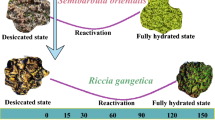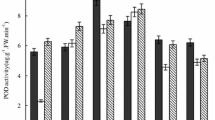Abstract
The ascorbate system, one of the major antioxidant systems, has been studied in two bryophytes; a moss, Brachythecium velutinum (Hedw.) B., S. & G., and a liverwort, Marchantia polymorpha L. The moss and liverwort gametophytes contain ascorbate both in the reduced and oxidized form; utilize ascorbate in removing hydrogen peroxide by means of ascorbate peroxidase and reconvert to ascorbate its oxidation products by means of dehydroascorbate reductase and monodehydroascorbate reductase. Ascorbate oxidase activity was measured in the cytosolic fraction suggesting a localization of the enzyme different from more evolved organisms. The ascorbate content was maintained in the moss after drought stress while it declines in the liverwort, which seems more sensitive to water stress. Since ascorbate recycling is more efficient in the moss than in the liverwort, this seems to suggest a correlation between efficiency of ascorbate recycling and water stress tolerance.
Similar content being viewed by others
References
Amako, K., Chen, G.X., Asada, K.: Separate assays specific for ascorbate peroxidase and guaiacol peroxidase and for chloroplastic and cytosolic isoenzymes of ascorbate peroxidase in plants.-Plant Cell Physiol. 35: 497–504, 1994.
Arrigoni, O., Calabrese, G., De Gara, L., Bitonti, M.B., Liso, R.: Correlation between changes in cell ascorbate and growth of Lupinus albus seedlings.-J. Plant Physiol. 150: 302–308, 1997.
Arrigoni, O., De Tullio, M.C. Ascorbic acid: much more than just an oxidant.-Biochem. biophys. Acta 1569: 1–9, 2002.
Arrigoni, O., Dipierro, S., Borraccino, G.: Ascorbate free radical reductase, a key enzyme of the ascorbic acid system.-FEBS Lett. 125: 242–244, 1981.
Bradford, M.M.: A rapid and sensitive method for the quantitation of microgram quantities of protein utilizing the principle of protein dye binding.-Anal. Biochem. 72: 248–254, 1976.
De Gara, L., Tommasi, F.: Ascorbate redox enzymes: a network of reactions involved in plant development.-Rec. Res. Develop. Phytochem. 3: 1–15, 1999.
Dhindsa, R.S.: Glutathione status and protein synthesis during drough and subsequent rehydration in Tortula ruralis.-Plant Physiol. 83: 816–819, 1987.
Dhindsa, R.S., Matowe, W.: Drought tolerance in two mosses: correlated with enzymatic defence against lipid peroxidation.-J. exp. Bot. 32: 79–91, 1981.
Esaka, M., Hattori, T., Fujisawa, K., Sakajo, S., Asahi, T.: Molecular cloning and nucleotide sequence of full-length cDNA for ascorbate oxidase from cultured pumpkin cells.-Eur. J. Biochem. 191: 537–541, 1990.
Gaspard, S., Monzani, E., Casella, L., Gullotti, M., Maritano, S., Marchesini, A.: Inhibition of ascorbate oxidase by phenolic compounds. Enzymatic and spectroscopic studies.-Biochemistry 36: 4852–4859, 1997.
Horemans, N., Foyer, C.H., Porters, G., Asard, H.: Ascorbate function and associated transport systems in plants.-Plant Physiol. Biochem. 38: 531–540, 2000.
Loewus, F.A.: Biosynthesis and metabolism of ascorbic acid in plants and of analogs of ascorbic acid in fungi.-Phytochemistry 52: 193–210, 1999.
Messerschmidt, A., Ladenstain, R., Huber, R., Bolognesi, M., Avigliano, L., Petruzzelli, R., Rossi, A., Finazzi-Agrò, A.: X-ray crystal structure of the blue oxidase ascorbate oxidase from zucchini. Analysis of the polypeptide fold and a model of the copper sites and ligands.-J. mol. Biol. 206: 513–529, 1989.
Noctor, G., Foyer, C.H.: Ascorbate and glutathione: keeping active oxygen under control.-Annu. Rev. Plant Physiol. Plant mol. Biol. 49: 249–279, 1998.
Ohkawa, J., Okada, N., Shimnyo, A., Tanako, M.: Primary structure of cucumber (Cucumis sativus) ascorbate oxidase deduced from cDNA sequence: homology with blue copper proteins and tissue-specific expression.-Proc. nat. Acad. Sci. USA 86: 1239–1243, 1989.
Paciolla, C., De Gara, L., De Tullio, M.C., Arrigoni, O.: Distribution of cytosolic ascorbate peroxidase in angiosperms.-G. bot. ital. 130: 729–737, 1996.
Pence, V.: Cryopreservation of bryophytes: the effect of abscissic acid and encapsulation dehydration.-Bryologist 10: 278–281, 1998.
Proctor, M.C.F., Smirnoff, N.: Rapid recovery of photosystems on rewetting desiccation on rewetting desiccation-tolerant mosses: chlorophyll fluorescence and inhibitor experiments.-J. exp. Bot. 51: 1695–1704, 2000.
Roy, S., Chandan K., Hanninen, S., Hanninen, O.: Monitoring of polycyclic hydrocarbons using “moss Bags”: bioaccumulation and responses of antioxidant enzymes in Fontinalis antipyretica Hedw.-Chemosphere 32: 2305–2315, 1996.
Seel, W.E., Hendry, G.A.F., Lee, J.A.: The combined effects of desiccation and irradiance on mosses from xeric and humid environment.-J. exp. Bot. 43: 1023–1030, 1992a.
Seel, W.E., Hendry, G.A.F., Lee, J.A.: Effects of desiccation on some activated oxygen processing enzymes and anti-oxidant in mosses.-J. exp. Bot. 43: 1031–1037, 1992b.
Smirnoff, N.: The carbohydrates of bryophytes in relation to desiccation tolerance.-J. Bryol. 17: 185–191, 1992.
Smirnoff, N.: The role of active oxygen in the responses of plants to water deficit and desiccation.-New Phytol. 125: 27–58, 1993.
Smirnoff, N., Wheleer, G.L.: Ascorbic acid in plants: biosynthesis and function.-Crit. Rev. Plant Sci. 19: 267–290, 2000.
Tommasi, F., Paciolla, C.: Cytosolic ascorbate peroxidase in Gymnosperms.-Plant Biosystems 134: 227–232, 2000.
Tommasi, F., Paciolla, C., Arrigoni, O.: The ascorbate system in recalcitrant and orthodox seeds.-Physiol. Plant. 105: 193–198, 1999.
Tommasi, F., Paciolla, C., D'Elia, F., Arrigoni, O.: Changes of ascorbate peroxidase and dehydroascorbate reductase activities during seed development of Vicia faba L.-J. biol. Res. 71: 341–346, 1995.
Trumper, S., Follman, H., Haberlein, I.: A novel dehydroascorbate reductase from spinach-chloroplasts homologous to plant trypsin-inhibitor.-FEBS Lett. 352: 159–162, 1994.
Author information
Authors and Affiliations
Corresponding author
Rights and permissions
About this article
Cite this article
Paciolla, C., Tommasi, F. The Ascorbate System in Two Bryophytes: Brachythecium velutinum and Marchantia polymorpha . Biologia Plantarum 47, 387–393 (2003). https://doi.org/10.1023/B:BIOP.0000023882.24490.51
Issue Date:
DOI: https://doi.org/10.1023/B:BIOP.0000023882.24490.51




